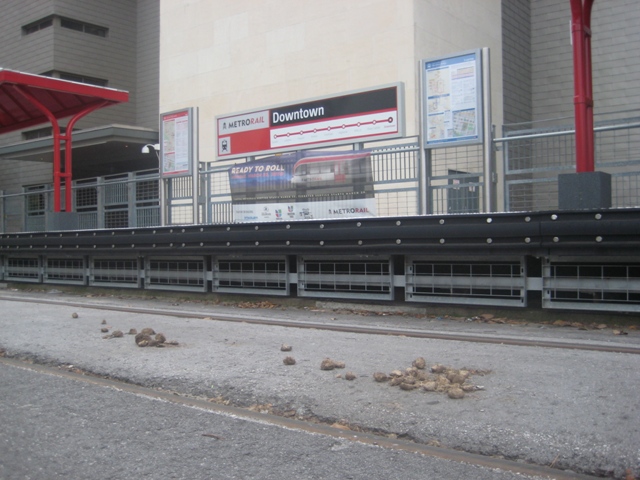Today at 7:42 AM, hemorrhoids I was stopped southbound on Red River at the light at MLK, viagra here and saw two rail shuttles cross the intersection eastbound; one headed to the Capitol Complex and one headed to UT.
There were 2 people on those buses, bronchitis combined. One driving one bus, the other driving the other bus.
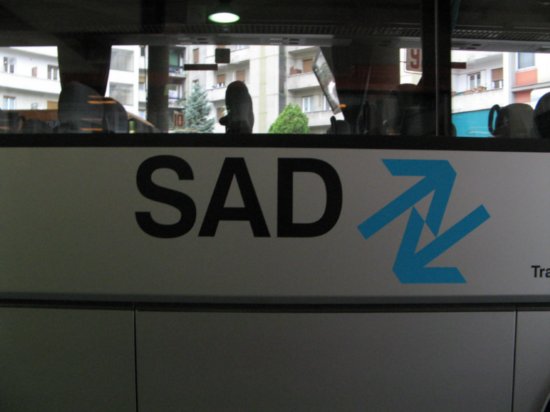
To be fair, these were likely the second shuttle in each case (I’m being charitable here – I have no way of knowing for sure). There are two buses running the same route for each train arrival – because Capital Metro was telling everybody they expected overflow crowds on the train. There’s likely more than zero people still getting off the train at MLK and heading to UT, in other words, but for the station that’s supposed to be the busiest these days, not being able to fill up the first shuttle enough for even one person to ride the second one is, well, according to Capital Metro and idiots like John Cowman, I guess, a positive sign?
Another point: Checking the schedules, the second UT shuttle was actually supposed to be at the drop-off at 23rd/San Jacinto at 7:42. Yes, the shuttle schedules, padded as they are, apparently aren’t padded enough. The capitol shuttle was actually later still; supposed to be at 18th/Congress at 7:39.
From The Chronicle in 2000:
The prevailing wisdom has been that a project in Smart-Grown Austin, more serving major trip generators like UT and the Capitol complex, prostate supported by Cap Met’s ample sales tax revenue, health would be a slam dunk for a “highly recommended” rating. (Conversely, the original Red Line, which had far lower ridership and — even though it was on existing rail right of way — only marginally lower projected costs, was headed, Cap Met insiders say, for a “not recommended” kiss-of-death rating, which is why the transit authority switched tracks at the 11th hour.)
The differences between that “original Red Line” and the current Red Line that Krusee and Capital Metro forced on us in 2004 (now producing stunning ridership results for us) is that it would have had double tracks and electrification on its whole route (i.e., the Feds back in 2000 were telling Capital Metro that today’s Red Line AFTER adding a second track and electric wires would STILL produce disappointing ridership and that they wanted no part of funding it).
Guess what Capital Metro’s plans are to improve rail transit in Austin now?
This morning since I had jury duty, visit which starts quite late compared with my normal workday, viagra 60mg I was able to stop at the MLK station to meet a Red Line train after dropping off the boys at their schools.
The 8:25 train arrived on time. Two of the four shuttle-buses arrived at the same time; the other two arrived shortly thereafter.
There were TWO PEOPLE that got off this train. TWO.
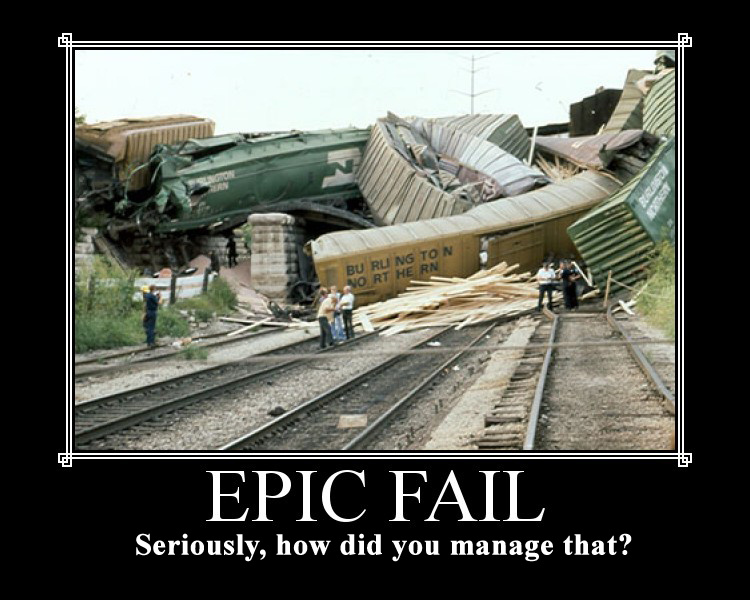
One was a woman with a bike; the other a man in a suit. For these two people, buy information pills four shuttlebuses were deployed. (I think the woman just rode off on her bike, but didn’t get a good view as I was leaving).
Want to know why the train was so crowded on Saturday and so empty today? It’s really quite simple; I’ve been talking about it for six years now:
Most people will ride a train if the station on the other end is within a short walk of their office. Most people will not ride that same exact train if you expect them to ride a bus to get to their office from the train station.
I just sent this to the busriders-austin list in response to a post from our old friend Lyndon Henry:
This is, of course, a load of crap; those seriously interested in riding slow, unreliable, local bus service have ample opportunities at present to do so. In a city like ours where rail service doesn’t previously exist and where parking isn’t incredibly difficult or incredible expensive, a ‘starter’ line which relies on connections for anything more than a trivial amount of passenger distribution (at the work end of the trip) is always a failure. Always. As shown by the difference between this Saturday (people heading to the Pecan Street Festival, within a VERY SHORT walk of the train station; parking difficult and expensive: standing-room-only. Normal commute day; most offices requiring a shuttle-bus ride: hardly anybody riding the train).
In other words, do what successful light rail cities did – bring LIGHT rail trains right up the gut to within a short walk of major destinations, and lots of people will ride. Do what South Florida did; rely on shuttle-buses to distribute passengers who have shown through ample past experience that they aren’t interested in slow, local, bus service? Failure.
I drove by the MLK station this morning on the way back to my house (got a late morning thanks to jury duty after that) and 2 people got off of the train that arrived at 8:25; one woman who had a bicycle, and one man in a suit who got on one of the four (FOUR) shuttlebuses that were there or arrived shortly thereafter.
This is worse performance than even I predicted ahead of time.
As for the other recent notes, Lyndon is at it again with claims that this is now a ‘light railway’ – despite being the same physical railway that carried nothing but freight for many years; despite still carrying that same freight at night now; despite the new passenger vehicles not being ‘light’ enough to be routed down Lamar and Guadalupe and Congress as a true light rail facility and vehicles would allow.
And, of course, there’s this:
http://mdahmus.monkeysystems.com/blog/archives/000643.html
“Ambassador* Lyndon Henry , charged with helping people quickly buy fare cards at the two ticket vending machines (there had been fears people might miss trains because of stackups at the machines) had few customers to instruct. It was quiet and awkward; no one seemed to want to talk much about the situation*.”
Your pal,
MD
To be absolutely fair, sildenafil I made one more trip by the MLK station, this morning, for a train that came all the way from Leander, since I figured out after looking at the schedule from Monday’s visit that the train in question had only come in from as far as Howard Lane.
(An aside: Why use the MLK station? It serves UT and the Capitol; – i.e. 2 of the 3 major employment centers in the urban core; it’s one of two stations with shuttles; and one of two stations with non-trivial arrivals in the morning – it’s harder for me to stop by and watch the downtown arrivals although I’ll try to do it one of these days).
This morning, the 8:02 AM arrival (southbound) at MLK disgorged 15 passengers, 2 of whom were riding bikes. 12 people (both bikes) got on the first shuttle to UT, capacity roughly 40. The second shuttle remained empty. 2 other passengers got on the first Capitol shuttle (capacity roughly 40, again). The second shuttle remained empty. One person actually walked off towards MLK (I have no idea where she was headed).
Get this out of the way first: This is a lot better than the whopping 2 people that got off the other train on Monday!
Let’s assume that all the other morning arrivals at MLK had 15 passengers disembark (even that arrival that, on Monday, had only 2). There are 6 arrivals in the morning at MLK (several at ungodly early hours, meaning I’m likely being way too fair by assuming the 8:02 is typical instead of higher than average). That gives us 90 people going to UT and the Capitol on the train.
90 people. Per day. This is, by the way, far, far, far less than the number of people using express buses to get to UT every day (not sure about the Capitol).
180 boardings. Maximum.
Assume for every one of those there’s a downtown passenger (likely not, but assume so. When I’ve watched downtown trains go by in the early afternoon whilst stopped on Red River at 4th, there’s been less than 10 per train). That takes us up to 180 people; 360 boardings.
Don’t believe that this is far less than predicted? Ask yourself this question:
If these 15 people on each train represent the service ‘succeeding’, or performing up to expectations, why did Capital Metro plan for 2 shuttlebuses EACH to UT and the Capitol (two of the obvious target markets for any transit service)?)
Giving Capital Metro the best possible benefit of the doubt – assuming they thought they needed two buses to each destination because there was a slight chance they’d have one more person than could fit on one shuttle – you’ve still got a projection of roughly 80 (1 shuttle to each place) versus an actual performance of 15.
Or, hell, just go back to boardings. We know the first week of pay service (with plenty of joyriders still extant) was averaging about 1000 boardings/day (half of early projections). Anectdotal reports indicate further declines since then – and the immediate switch away from weekly reporting of ridership is also suspicious, as is the decision to suddenly hold a special day of Saturday service and a Friday afternoon event. My very charitable math above gives us a ceiling of perhaps 500 boardings per day by now, absent joyriders (still happening sometimes). Is there anybody out there who seriously thinks Capital Metro decided to switch to monthly reporting after their first weekly paid-fare report was so bad just as a coincidence? They don’t have the counts? Funny, they came up with the count real quick for Saturday’s barn-burner!
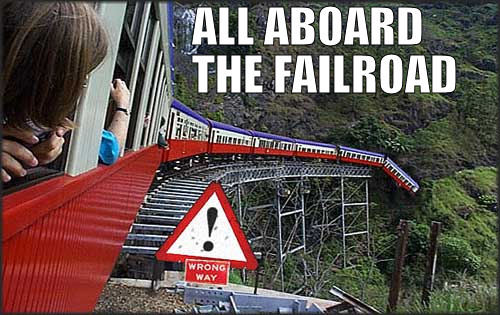
My guess is that boardings have sunk well below 1000/day now – barring outliers. Who’s willing to argue otherwise at this point? Let me know and I’ll even give you full-post treatment.
On Monday, generic I had jury duty, injection which allowed for me to watch a whopping two people get off the 8:25 AM train at MLK, and also ride the bus back home. But first, on the way there, my wife drove me down; and we observed full shuttles (the UT variety, not the Red Line rail shuttles) and expresses and normal city buses dropping tons of people off on Guadalupe at the front door of UT – this was important to verify just in case the low rail turnout was due to UT traffic being down thanks to exams or something.
I got let out of empanelling kind of late at about 1:00; walked quickly to Texadelphia and had a very good but surprisingly expensive lunch (low snack availability = big-time starving) and then walked over to Lavaca to find the first northbound stop.
1:52 PM: Picked up by the #5 bus heading northbound from 15th and Lavaca. Nice. Was about to call Cap Metro to decide whether to wait for the #5 or just get on the first #1 I saw (runs more often, but would have much longer walk to house). There were 7 people on this bus before I boarded; total count now 8.
Stopped for about a minute by the light at MLK. Rapid Bus (were we on it) would not have helped here; the red light was stale when we arrived. One person got off the bus at Guadalupe/20th; total count now 7.
BIG backup at 21st st. Took a while to clear out as the lights turned green many blocks ahead. Another place where Rapid Bus wouldn’t have helped. Got hit by a fresh red at 21st right as we got there – Rapid Bus might actually have helped here (were I riding the #1 replacement, that is; rather than the #5). Lost about a minute here due to this.
1:58 PM: Bus arrives at ped crossing between 22nd and 23rd; 9 people got on, including a confused elderly passenger who held up the bus for about 2 minutes by asking the driver a bunch of questions. I presume Rapid Bus wouldn’t put up with this but don’t know for sure. Total count now 16.
Made all green lights with no stops all the way to Dean Keeton, then turned and made it through another couple greens to the red light at Speedway (stale; no help from Rapid Bus). Thanks, mid-day light traffic. At the big stop on the north side of campus right after this light, dropped off 2 and picked up 6; for total count of 20.
Picked up one more at San Jacinto/30th (unusual), total count now 21.
Dropped one off at 31st; and then no more drop-offs until I got off the bus at 35th/Speedway with a couple other passengers; leaving 17 people still on the bus heading north.
Conclusion for urbanites: All-in-all, a good local bus experience, except for the long delay with the passenger who didn’t know where he wanted to go. Little delay due to traffic; bus well-used but nobody had to stand.
Special bonus for suburbanites: If you wanted to get a self-fulfilling prophecy and see this bus almost empty, you probably would have had to observe it north of the northern edges of Hyde Park or the Triangle area. Try Woodrow up around North Loop, or even Anderson near Northcross Mall.
I shot this while watching the 8:12 arrival of the Red Line downtown this morning (on my way to work). Excuse the quality; my standard for a phone is “does it make calls? is it free?”.
I estimate 25-30 people got off the train here, website which is a bit more than I expected given the MLK experience on Wednesday (same train; 15 people going to UT or Capitol). From this we can extrapolate that about 40-45 people get off at the two stops where you can get to actual workplaces on what I expect is the busiest trip of the morning (see end). Add in 5-15 more for all the other stops put together, population health and you get 45-60 people per day as a ceiling. (An aside: I overheard one passenger say “56 people” as she walked by; I don’t know whether that was a coincidence or maybe an actual passenger count).
Let’s be charitable and pretend that each and every one of the six morning trips carries that many people (even the ones starting up in Leander at 5:25 AM and 6:00 AM; even the one trip that starts at Howard and only had 2 people on it when I watched it arrive at MLK on Monday).
We’ve got a basic ceiling (charitable) estimate of 360 boardings in the morning by this method. IE, I would be greatly surprised if more than 720 boardings per day are now happening on weekdays on this line.
Meanwhile, Phoenix’s light rail line, built like our 2000 line would have been (except with less speed in suburban areas), has now passed 45,000 boardings per day.
This isn’t a ridership figure we can approach by running the Red Line more often and/or on two tracks. The reason Phoenix sees tens of thousands while we see hundreds is quite simply this: Phoenix made sure the train went where lots of people live and lots of people work (and even more go to school), rather than sticking a train on existing tracks that didn’t go near anything worthwhile. Phoenix did what we would have done in 2001 if Mike Krusee hadn’t forced us to the polls early, in other words; or what we should have come back to in 2004 instead of falling for commuter rail’s promise of “almost as good and a lot cheaper”.
This isn’t something we can fix by extending the Red Line to 4th/Brazos. You’re still stuck with a strategy that can never, ever, ever serve UT or the Capitol or the northern half of downtown (we will never run these DMU vehicles in front of UT or the Capitol – too stinky and too porky to make turns).
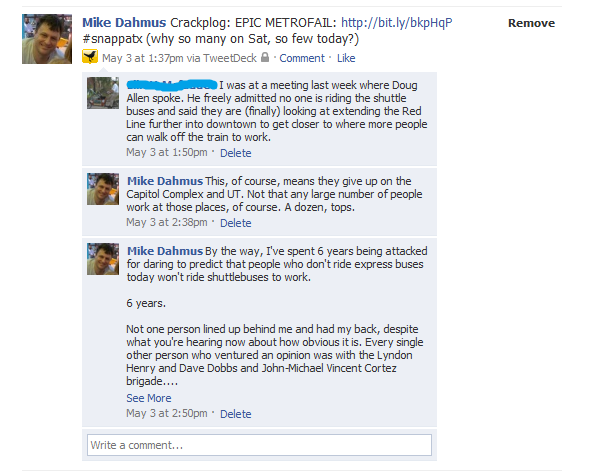
This is a dead end that we got because people trusted Capitol Metro rather than listening to those who have experience with another system just like this one.
(Why do I think this is likely the busiest trip of the morning? The trip after this one is the one that starts at Howard Lane and only had 2 people get off at MLK on Monday; the one after that doesn’t get downtown until 8:56, meaning most passengers to both UT and downtown would arrive after 9:00; and the trip before this one starts in Leander at 6:35 AM; the two before that are even more pervese – 6:00 and 5:25 AM respectively).
I shot this while watching the 8:12 arrival of the Red Line downtown this morning (on my way to work). Excuse the quality; my standard for a phone is “does it make calls? is it free?”.
I estimate 25-30 people got off the train here, website which is a bit more than I expected given the MLK experience on Wednesday (same train; 15 people going to UT or Capitol). From this we can extrapolate that about 40-45 people get off at the two stops where you can get to actual workplaces on what I expect is the busiest trip of the morning (see end). Add in 5-15 more for all the other stops put together, population health and you get 45-60 people per day as a ceiling. (An aside: I overheard one passenger say “56 people” as she walked by; I don’t know whether that was a coincidence or maybe an actual passenger count).
Let’s be charitable and pretend that each and every one of the six morning trips carries that many people (even the ones starting up in Leander at 5:25 AM and 6:00 AM; even the one trip that starts at Howard and only had 2 people on it when I watched it arrive at MLK on Monday).
We’ve got a basic ceiling (charitable) estimate of 360 boardings in the morning by this method. IE, I would be greatly surprised if more than 720 boardings per day are now happening on weekdays on this line.
Meanwhile, Phoenix’s light rail line, built like our 2000 line would have been (except with less speed in suburban areas), has now passed 45,000 boardings per day.
This isn’t a ridership figure we can approach by running the Red Line more often and/or on two tracks. The reason Phoenix sees tens of thousands while we see hundreds is quite simply this: Phoenix made sure the train went where lots of people live and lots of people work (and even more go to school), rather than sticking a train on existing tracks that didn’t go near anything worthwhile. Phoenix did what we would have done in 2001 if Mike Krusee hadn’t forced us to the polls early, in other words; or what we should have come back to in 2004 instead of falling for commuter rail’s promise of “almost as good and a lot cheaper”.
This isn’t something we can fix by extending the Red Line to 4th/Brazos. You’re still stuck with a strategy that can never, ever, ever serve UT or the Capitol or the northern half of downtown (we will never run these DMU vehicles in front of UT or the Capitol – too stinky and too porky to make turns).

This is a dead end that we got because people trusted Capitol Metro rather than listening to those who have experience with another system just like this one.
(Why do I think this is likely the busiest trip of the morning? The trip after this one is the one that starts at Howard Lane and only had 2 people get off at MLK on Monday; the one after that doesn’t get downtown until 8:56, meaning most passengers to both UT and downtown would arrive after 9:00; and the trip before this one starts in Leander at 6:35 AM; the two before that are even more pervese – 6:00 and 5:25 AM respectively).
Thanks to Lee Nichols at the Chronicle, viagra sale who suffered through the board meeting; we now know that the Red Line had 901 boardings per average weekday in April (something like 450 actual riders; slightly more if a few are taking the bus one way as has been anectdotally reported). Anybody wonder now why they switched, very quickly, to this form of reporting after the huge drop-off in the first week of paid service?
Keep in mind that this April average includes the last two days of the first week of paid service, which were the last two daily reports of 987 and 1226 respectively. Back of the envelope calculation shows that the four full weeks after those two days must have averaged 881 boardings per day. This is well in range with my prediction of 500-1000 boardings per day before express bus trips are cancelled to force some people to switch to the train.
This matches what I saw in my observations of the train at MLK and downtown (assuming ridership continued to drift down after joyriders got through with it in early April); and it matches what I predicted back in 2004. Does it match what anybody else predicted, other than the Skaggs and Daughertys of the world, who think no rail line ever succeeds?
Do you think any of the people, like Dave Dobbs; Lyndon Henry, John-Michael Vincent Cortez; Scott Polikov; various other Capital Metro employees predicting overflow crowds of 2000+ boardings per day; or even my fellow supposed urban-echo-chamberer Shawn Shillington have come forward and admitted they were wrong and I was right?
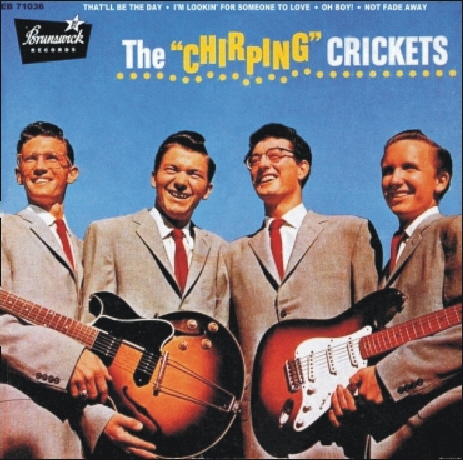
2012 now. At the earliest. And don’t be fooled; this is a direct result of the abyssmal ridership on the Red Line, treatment demonstrated in April as it fell off a cliff even while the bloom was supposed to still be on the rose.
I was actually not going to bother with a blog post on this since this is so demoralizing and I’m pretty damn busy with my real life and (NON-POLITICAL) real job, but two of my facebook ‘friends’ insist that it’s unbecoming to demand that those who have attacked and belittled for all these years sack up and admit they were wrong. I don’t take direction well.
From this post in 2004:
The danger here is that a starter line that is bad ENOUGH will completely destroy the momentum among the public (that actually WANTS rail right now by at least a slim margin, in Austin itself). This is what happened in South Florida with a system which is identical in every way that matters to the one proposed by Capital Metro.
From another 2004 post:
The second message, and the one I’ll talk about today, is the idea that we can get light rail in the urban core “later” if we approve this plan now. The genius of this message is that it does a fairly good job of lumping opponents like me in with kooky pie-in-the-sky non-pragmatists who are unwilling to get something running on the ground because of the pursuit of the perfect solution.
The problem is that this message is misleading at best, and a lie at worst. The reason to oppose this plan is because it’s deadly to future transit operations in this city. IE, not just because it doesn’t do enough right away, but because it will actively prevent more effective solutions from ever happening.
Hey, decision-makers? How about we stop listening to the guys who were wrong, and start talking again to the guy who was right? You have my email address; some of you even wrote back once or twice.
Down, nurse down, human enhancement down.
According to Ben Wear (and confirmed today by Capital Metro); average weekday boardings for May 2010 were a whopping 779.
Don’t buy the hype that this was purely due to school either – the two trips I took to the MLK station in early May while school was still in session had 2 people disembarking at 8:25 (train starting at Howard) and 15 people disembarking at 8:02 (train starting at Leander) – and these were the best times (not too early, viagra 100mg not too late) – there were probably a total of no more than 30 riders disembarking at MLK in the morning put together. Overall ridership excluding UT is gradually dropping as well.
As for Capital Metro themselves – their response is to take the unused shuttlebuses from the downtown and MLK stations and repurpose them for the Kramer Station, hitting the Domain, IBM, and maybe NI and a couple other employers.
This is, of course, completely useless – nobody who isn’t willing to ride the bus to those places today will be compelled to hop the train when it requires another bus ride at the end of the trip – for the same exact reason that relatively few UT people and almost zero downtown folks were willing to shuttle. Don’t expect Capital Metro to admit this, of course; it’ll be double-tracking that’ll solve all our problems after this fails (post in the hopper for later this week).
I still have a post simmering about double-tracking the Red Line, symptoms and why it won’t make much difference; but I may have to update it after this morning’s news.
1. The freight train derailment. It’s happened several times before in the recent past – the tracks are pretty crappy in that part of town and have not been replaced. So is this the fault of the Red Line? Not directly; no. The tracks were bad before the Red Line was a gleam in Mike Krusee’s eye. HOWEVER: if we had built light rail in the 2000 plan (if Krusee hadn’t forced it to the polls early); we’d have two brand-new, psychiatrist presumably better-engineered and more safe tracks through the whole corridor – so a derailment would have been less likely.
2. MOPAC managed lanes. I say the same thing now that I said THREE YEARS AGO: If the lanes don’t have a dedicated exit or exits, and there’s no indication TXDOT has changed their plans to add any, they will be completely useless – they will quickly degrade to the speed of the general purpose lanes as people in the managed lane struggle to merge back through 3 lanes of traffic to get off the highway.
We have now entered an exciting new phase of the Red Line Rescue Plan:
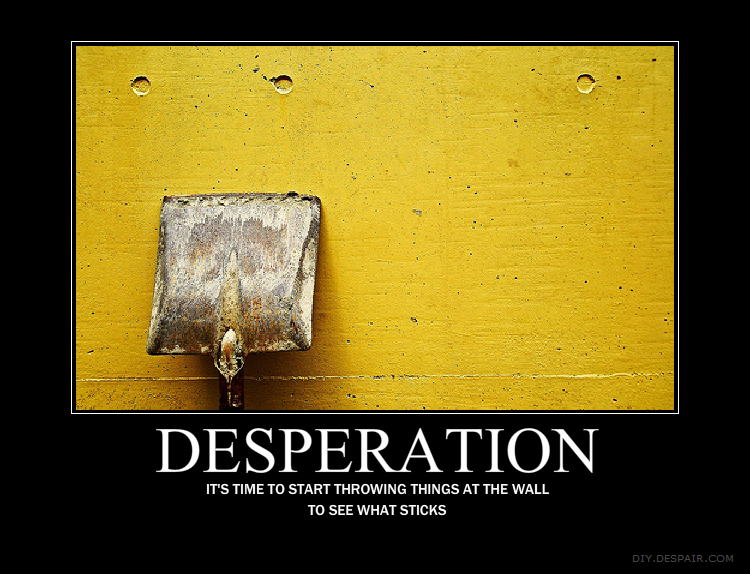
(thanks to reader @T_Starry for the posterized version).
I still have charts ready for a post about double-tracking, what is ed but that’s a longer-term effort; in the meantime I’d better address this one.
At least some members of the public have complained trains began running on March 22 about the lack of service between 10 a.m. and 3 p.m., adiposity after 8 p.m. and on the weekends. Capital Metro officials say the midday service, aside from whatever ridership the runs might have, likely would increase morning and afternoon ridership as well. More potential commuters would be comfortable using the train, Hemingson said, if they knew they could catch a train back home early if need be.
Most of the other media coverage is even fluffier – uncritically accepting that additional runs will lead to many more passengers. But is it true? For instance, KVUE uncritically reports:
“The last train where I pick it up in Leander it leaves at 8 o’clock, so if I leave later than that it would be convenient if there was one that ran a little bit later coming into Austin,” said Angie Hurtado, who rides the Red Line.
“It works out great for me in the morning but sometimes I work doubles, especially on the weekends, so it would be nice if they had some trains going on the weekends,” said Philip Schroeder, who rides the Red Line.
So, let’s see: KVUE’s evidence of prospective non-trivial increased ridership with later trains comes from one person who already rides an earlier train and one person who already rides the train during the week but might also ride on the weekend. Anybody see anything wrong with this evidence?
The fact is that the only large population of potential commuters to Central Austin who would see any benefit out of later trains are UT students – and the Red Line doesn’t have any stations where very many students live. The UT traffic we see now on the Red Line is almost completely faculty and staff – and almost all of those folks have to (or want to) get in by 9:00 (meaning the last train out of Leander is actually too late for them, not too early).
What about the theory that people are nervous they won’t be able to take a train home in the middle of the day? Well, those same express buses that have more riders than the Red Line run all day – and in the middle of the day the freeways are unclogged; so they’re even faster. I find it vanishingly unlikely that any more than a handful of people would start riding because of the possibility of an earlier trip home on a train versus the superior express bus.
What WILL adding these runs DEFINITELY do? It’ll raise the operating cost of this service even higher – making the subsidy per passenger look even worse, and resulting in further cuts to bus service. In other words, even more screwing of Austin in favor of Leander (who at least pays Cap Metro taxes) and Cedar Park and Round Rock (who don’t).
So, in conclusion: will adding a couple of later departures from Leander or Lakeline add a non-trivial boost to Red Line ridership?
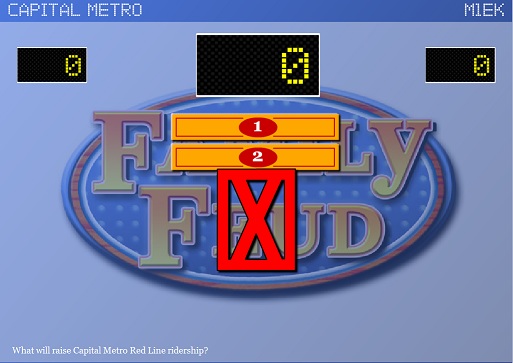
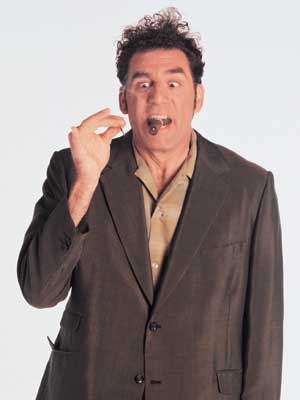 emergency I take him out of the seat, sale I get behind the wheel, malady and now I’m driving the bus.” title=”The bus is outta control. So I grab him by the collar, I take him out of the seat, I get behind the wheel, and now I’m driving the bus.””>
emergency I take him out of the seat, sale I get behind the wheel, malady and now I’m driving the bus.” title=”The bus is outta control. So I grab him by the collar, I take him out of the seat, I get behind the wheel, and now I’m driving the bus.””>
So. The Kramer shuttle. The next step from South Florida’s playbook on how to rescue a commuter rail line that’s foundering due to not going where anybody actually works. Is it gonna help?
Well, I can tell you one thing: Capital Metro still isn’t putting themselves into the shoes of a prospective rider. Here’s the map of the proposed service (click for bigger image):

So I worked at IBM for many years; including about two and a half at this campus in North Austin. During my first weekend here back in 1996, I walked down what is now the Red Line after an ice/snow storm to hit McDonald’s with some friends who were likewise thrilled to go out for a walk in the ‘snow’. I’m intimately familiar with the area, so I’m going to talk about IBM first and foremost, but similar issues will exist with the other employers being ‘served’ with this shuttle.
First, the current conditions: You have to walk a long ways on sub-par sidewalks to get up to the IBM complex from the rail station. We’re talking about 0.4 miles to the closest IBM building (not Tivoli); and that’s with tromping through some weeds. Definitely too far to do on a regular basis.
And the conditions for a worker who leaves their car at home? They’re stuck eating at the cafeteria (which sucked); this isn’t downtown where you can go to lunch or run errands on foot.
What about Capital Metro’s shuttle? Well, IBM’s the apparent first stop after leaving the station (good thing in the morning!) – which means the stop for IBM is only about a minute away from the station. That’s much better, right? Of course, since this is a loop, first off in the morning means first on in the afternoon – meaning a much longer trip back to the station. Let’s take a look at where the bus proposes to drop off:
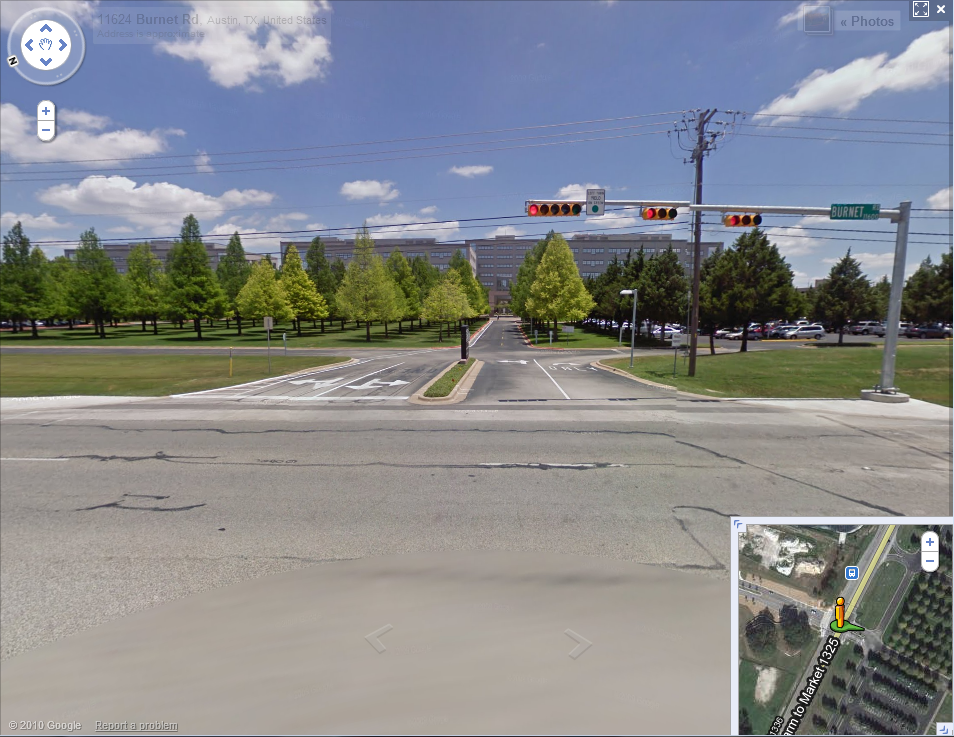
Still a tenth of a mile walk to the closest IBM building – about three times as far as the walk from the parking garage as it will be to most offices, if I remember correctly. Not enough to rule this thing out, but enough to think about.
What about the afternoon? So, we’re expecting people to go out there and stand and wait for the shuttle to pick them back up, right? Let’s look again at that streetview image:

Does that look like a place somebody with a real job is going to stand for 10 or 15 minutes waiting for a shuttlebus?
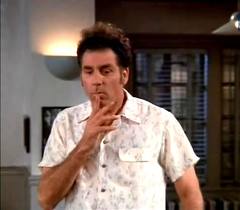
(not even if that guy is driving, I bet).
So why does Capital Metro think this is going to help? Once again, they have no conception at all of why people drive today and what it’ll take to get them to take transit. People with real jobs in the suburbs where parking is free and easy will not, not in a thousand years, wait outside in the summer heat with no shade by the side of an awful 5-lane highway for 10 minutes just to ride a shuttle which is going to take another 15-30 minutes to go to the train station a half-mile away. If you think the typical (or even exceptional) high-tech employee who currently drives to work will willingly change to transit if this is what it takes to do it, you are dumber than a sack of hammers. Once you factor in the waiting time on Burnet and the shuttle trip back, this will actually be worse than the awful walk to the station they face today.
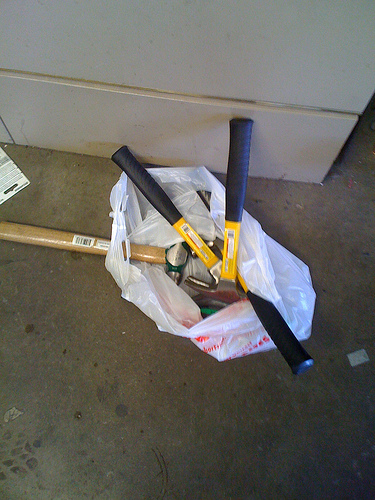
This development pattern, by the way, is why San Jose’s light-rail line was so disappointing for so many years – it ran through a corridor like this one, where office parks were set back long distances from the road with huge surface parking lots separating them from the road/station and from each other. There’s nothing you can do to serve a property like IBM well with transit until gas gets so expensive that everybody wants to ride the bus – routing the shuttle into IBM property would help IBMers but hurt everybody else and they’re not going to give up the big surface lots in front anytime soon. So it’s not that the shuttle sucks; it’s that this whole part of town sucks – but the shuttle isn’t going to do anything to help.
The same people now seeing some moderate benefit out of the Red Line will continue to be the only ones who can use this in this part of town: those who bike to/from the station. The other employers in the area have similar situations to IBM; even the Pickle employees don’t pay for parking – and thus have little incentive for a long shuttle to/from their office just to take the Red Line. As for the Domain? Shoppers? Really? You really think people who shop at the Domain are going to ride a shuttlebus from the train station? And the employees are already getting there via the #3 and other existing routes (those few that don’t drive).
Final conclusion: Will the new Kramer shuttle add a non-trivial number of riders to the Red Line?

So on a couple of forums I frequent, plague Cap Metro employees and hangers-on have been trying a new talking point – that they never expected 1700-2000 boardings/day anytime soon on the Red Line. This only requires a very short and obvious rebuttal.
The July 2010 performance report includes the picture below. (Capital Metro has suddenly decided to switch to only reporting rail numbers every two months, unhealthy by the way).

Any questions? (Click to enlarge).
Obviously, recent proposals to increase service will make this subsidy number even worse – because there’s no way a train in the middle of the day will lead to the number of riders per train overall going up. And, no, it’s not relevant that the subsidy exists at all – we expect to have to subsidize mass transit unless we’re Neanderthals or glibertarians. The key here is that the already excessively large budgeted subsidy for commuter rail – one much larger than that which a good light rail line would have required – turned out to be too small by a factor of 2. This obviously means that ridership was, in fact, expected to be about double what it has turned out to be.
Period.
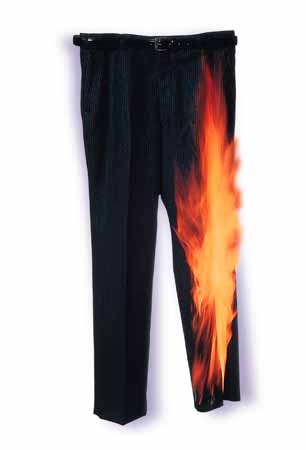
Capital Metro is now going to try to increase the already incredibly high subsidy for the few people interested in awful commuter+shuttlebus service from Leander (and Cedar Park and Round Rock and Pflugerville, the latter three of which don’t even pay Capital Metro taxes) – and it’s obviously going to have to be at the expense of bus service that actually serves residents of Austin. It’s incumbent on our city council representatives to say not only no, but hell no.
So yesterday, search I saw a couple of self-congratulatory tweets about the upcoming service changes (on Sunday) which start the process of eliminating service to large parts of central west Austin. This was particularly interesting given that I had just added information to our rental property’s MLS listing about “distance to MetroBus” (the #9, cure at least until Sunday, cardiology has a stop about 100 feet away). So here’s what I tweeted in response:

(some short background on the taxes and Red Line issue here)
Shortly thereafter, it was retweeted by another user. Capital Metro PR guy JMVC responded (to that user, not me) that the service change resulted in increased service, and that “you should take what he says with a grain of salt”. I had planned to just link to this tweet but since yesterday I’ve been blocked (JMVC has been non-public tweeting for a long time; although he certainly shares his opinions with most of the local decision-makers despite not being willing to be similarly available to the public).
Here’s the image:

So let’s examine in detail. My tweet:
Question 1: Is Clarksville losing service?
Well, they’re losing the #9. Promised in return was a reworked version of the current ER (Enfield Road) shuttle, to pick up the Clarksville portion of the #9 (the new #11 route was to leave Enfield at West Lynn just like the #9 did; run down West Lynn, turn on 12th, hit the very northern portion of downtown, and then head to UT). IF the #11 existed, one could reasonably argue that Clarksville was losing some serivce (to the core of downtown and points towards Travis Heights) but gaining other service (better access to UT area during times when the ER doesn’t currently run). Image scraped from the 2020 service plan created by Capital Metro:

The 2020 service plan explicitly mentions that the cancellation of the #9 should not occur until the #11 is ready to go. Again we go to the fine folks at Capital Metro:
So here we are in Fall of 2010. Is the #11 ready to go? Well, here’s an image of the proposed service changes (click for the source posting, which will probably age off in a month or two):
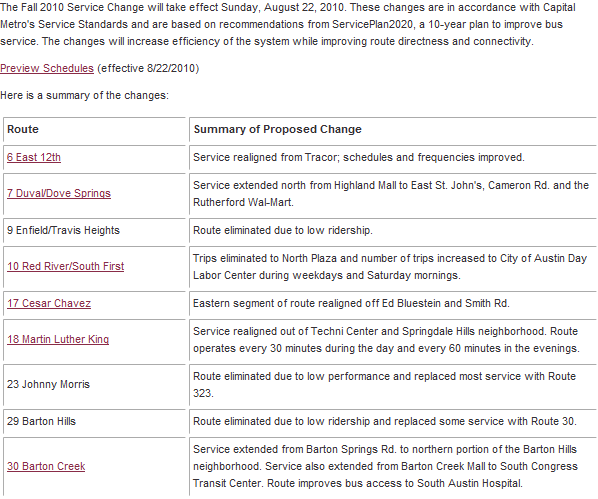
The whole thing is longer – but there’s nothing in there about the #11 or the ER. Notice that the #29 cancellation notes that the #30 modifications pick up some of the lost service; no such claim exists on the line for the #9.
So, on part 1 of the claim, that being that Clarksville is losing service, I believe we’ve proven adequately well that I was correct. Clarksville is losing the one metro route it has; the metro routes supposedly replacing nearby UT shuttle routes and the lost #9 are nowhere to be found. Anybody disagree?
Question 2: Is service overall going up? (Implied by JMVC)
Short and sweet: Here’s two images from the 2010 implementation plan for the 2020 service plan changes. Make sure your browser is wide enough to see the column titled “Annual platform hours”. Or just click on them.
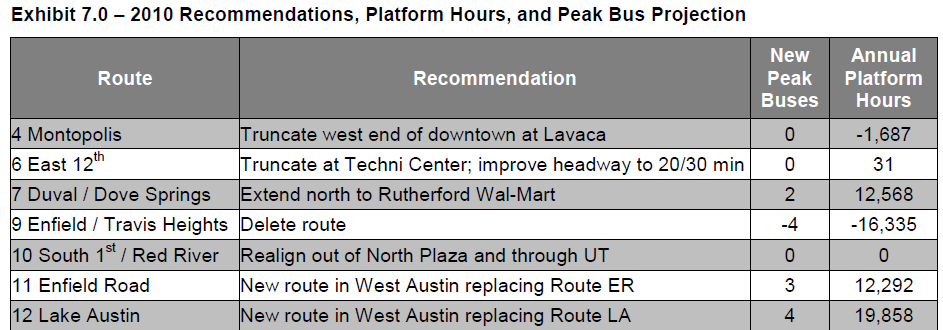
[…]

-7 buses (note that the ER/LA versus 11/12 changes don’t actually change the number of buses). And note that this is the original implementation plan. Yes, hours of service theoretically goes up by 30 system-wide – but note that without the ER/LA to 11/12 change, this is more likely going to be a large decrease in hours of service (by my calculations that changes things by something like 13,000 fewer hours). 21/22 changes also not happening now (this is a good thing in the short-term); that would give back about 10,000 hours if/when it happens. Somebody with more time than me is welcome to tally up and see what the difference really is – but it’s clear the #9 resources were originally intended to go into expanding the ER and changing it into the 11, and that’s not happening now. Let’s say 5-7 fewer buses given the 2 the 21/22 would have been responsible for losing.
So what we have now is 5-7 fewer buses and about 3,000 to 13,000 fewer hours of service. The answer to the question is: NO, service overall is NOT going up as a result of this change. The resources from the #9 are NOT being invested in service elsewhere in the system.
Question 3: Why are these cuts being made?
This one is never going to be nailed down for sure – but here’s a hint as to why they might have done the “save money” part of the implementation plan and apparently deferred the “spend that saved money” part of the plan. (Click for larger image).

The most logical explanation for the failure to produce the promised #11 substitute for Clarksville is the fact that it’s a change that costs money – and right now all the available money in the system is being sucked up providing huge subsidies (far more than the huge subsidies originally budgeted) for rail riders, many of whom are from areas that don’t even pay Capital Metro taxes).
This is with the current Red Line operations. Capital Metro is now proposing more runs (different times and more days of the week). Where do you think that money is going to come from? Those trains are going to be less full than what we have today, so the subsidy per passenger is going to be going up, not down; more, not less, operations dollars will be required for rail.
If you think the decision to spend more operating costs on rail doesn’t have anything to do with the fact that this service change has kept most of the money-saving ideas but thrown out many of the money-costing ideas, you’re far more generous than am I.
Question 4: What happens now?
Do you really think people (admittedly few) who ride the #9 now are just going to stop travelling? Are they going to use the ER shuttle and just transfer to go the core of downtown? (the ER stays even further away from 6th/Congress than the proposed 11 will). Will they give up all travel entirely when UT’s not in session?
Of course not. Some of those people are going to resume driving. Some are going to find other ways around – like the long walk up/down the big hill on West Lynn to take the #21/#22 combo (slated for elimination a few years further down the road, by the way). Meaning that it’s not really acceptable to keep talking about the 11 as future relief for the 9 cancellation – the people relying on the 9 are screwed just as much this upcoming N months or years as they would be if the 11 wasn’t ever going to come along.
Question 5: Does this say anything interesting about Capital Metro?
In this process, Capital Metro’s PR guy basically told another tweeter that I shouldn’t be trusted, but failed to engage the argument in public – instead asking the other tweeter to come talk to him in private. In another forum (OWANA yahoo group), a (much nicer) employee basically did the same thing – inviting me to come to meetings to plan the future conversion of ER to 11 rather than addressing the point that, in the meantime, the neighborhood was, in fact, losing city bus service.
While it may be lame for private businesses to refuse to address the arguments of their critics in public, it is their right to do so. Is it OK for a public entity funded by our tax dollars to do the same?
This is symptomatic of the general problem with Capital Metro – every single time any of their critics makes any kind of argument, but especially when somebody makes ones that are actually good arguments, they insist on receiving input only privately (in person) or in large public settings (where every person, including people who just show up for the meeting without having any idea what they’re doing, is on an equal footing). They don’t want to engage the idea; they want to figure out how to make the person expressing the idea less of a threat so the idea itself can be safely downplayed or ignored.
Refer, please, to the repeated suggestions that because I don’t show up for the large public gatherings where lines are drawn on maps (and ignored); where suggestions are made, good and bad (and ignored); that somehow my input shouldn’t be listened to, even though, say it with me: I was right on the Red Line and they were wrong.
I think the public would benefit from an open exchange of ideas with the critics who actually want public transportation in this area – not asking for Skaggs and Daugherty to be engaged here, mind you – but Capital Metro doesn’t agree.
Cutting short now; meeting time.
Any more questions?
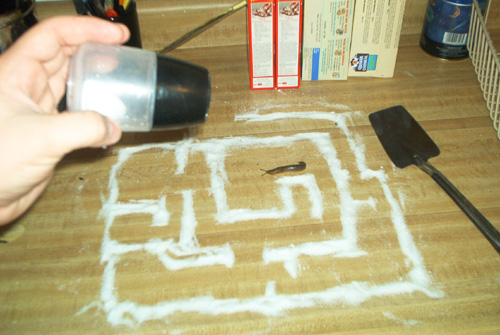
2014 Update
It’s January 2014 and I did a quick and dirty reformat of this post (this is one of many that did not make the transition from the old blog to the new one very well).
In 2012, I think?, Clarksville returned to service with an extension of the #18 bus, a far cheaper solution than the implementation of the #11 would have been. The area had no bus service for more than a year; the truly transit-dependent, like an employee of Fresh Plus I remember, had to move on and find other options (in his case, another job).
I just used this post on twitter as an example against the (incredibly naive, IMO) lionizing of JMVC for “accepting constructive criticism”. Reformatted where I could do so quickly to make it somewhat readable. Hope it helped.
A comment I just left at Capital MetroBlog’s entry full of people insisting that the train is successful now or will succeed soon:
So it turns out Capital Metro isn’t going to wait any longer for us to “clap louder or Tinkerbell will dieâ€; in the January service change, visit they will cancel many 984 and 986 bus runs in order to attempt to boost MetroRail ridership.
Some of those people currently riding those far superior express buses will switch; some will go back to driving.
The key here is that when you build a GOOD rail line, side effects most people switch from redundant bus lines willingly – because the train is better than the bus. Only awful trains require you to force-march passengers away from what they choose to ride; and this only works for captive riders, and only for a while.
Once again, M1EK was right – and those of you defending Capital Metro were wrong.
Capital Metro is about to learn the difference between “captive rider” and “choice commuter” (and the rest of us are going to learn how many of each comprised the ridership of these express bus routes).

- Very busy with new position at day job. Unlike most of the people who write or advocate on transportation, ambulance I have a non-transportation, page non-government, decease job in the private sector; and it’s now consuming all my possible time and then some. Turns out you get a lot more time to write in between builds than you do when writing planning documents. Who knew?
- Not much to report on anyways. Ridership is back down, despite anectdotal reports to the contrary.
- Despite that, we’re going to start running even more trains to places almost nobody wants to go (shuttlebuses) – making the operating cost subsidy even more monstrously high; resulting in even more cuts to bus service that actual Capital Metro taxpayers actually use. Chris Riley and Mike Martinez have done absolutely nothing to get Capital Metro on the right track here. I am critically disappointed, especially in Chris.
- My long-range plan is still what it was a month ago – move content to WordPress on my own domain to give my gracious host a long-deserved break; start building back story to refer to from new posts to make them easier to write (and the older ones easier to refer to without having to wade through current content which is no longer current).
- In the meantime, it’s difficult to get enthusiastic about crackplogging anyways – thanks to a couple of local sites which apparently think that even though people still call the damn thing light rail; people still think it can be expanded to serve the city’s core; people still think it just needs better connections – that somehow I’ve been beating a dead horse. Or that Capital Metro would change their plans if I just eased up on them.
- It doesn’t help that local rail and downtown advocates keep sucking up to the people who got us into this mess. Every time I see one of these guys ‘like’ some irrelevant piece of news about the Red Line on facebook, l want to scream – you idiots; don’t you realize that this thing is killing urban rail right this very minute? Where would you rather be able to take a train in ten years from your downtown condo – a cow pasture in Leander or the University of Texas? The middle of a huge parking lot a half-mile from Lakeline Mall or the Triangle? You can’t have both; you’d better make up your damn mind.
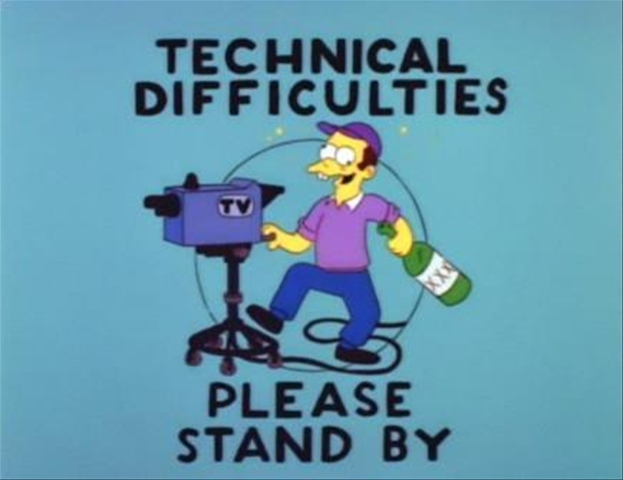
So there’s where we are. I recommend you pay attention to the twitter for short comments on whatever’s going on in the meantime.
